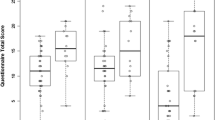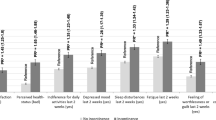Abstract
Introduction and hypothesis
The coexistence of urinary incontinence (UI) and depression has been intensively examined in women. This study aimed to investigate the prevalence and some clinical correlates of depression in women with UI.
Methods
The National Health and Nutrition Examination Survey (NHANE) 2005-2018 was used in this cross-sectional study, and a total of 7250 UI patients were included. Patientss were defined as having UI if they answered "yes" to the UI screening question. Depression symptoms were measured by Personal Health Questionnaire (PHQ-9).
Results
The age-standardized prevalence of depression in women with UI was 13.7 (95% CI: 12.5-14.9). Multiple logistic regression showed that being younger (age <60 years), widowed, divorced or separated and having lower income, lower education level, more severe incontinence and mixed UI were associated with an increased likelihood of depression.
Conclusions
This population-based study suggested that the prevalence of depression in women with UI was high. The main clinical correlates for depression were younger age (<60 years), lower education level, lower income, being widowed, divorced or separated, and having more severe incontinence and mixed UI.
Similar content being viewed by others
References
Haylen BT, et al. An International Urogynecological Association (IUGA)/International Continence Society (ICS) joint report on the terminology for female pelvic floor dysfunction. Neurourol Urodyn. 2010;29(1):4–20.
Aoki Y, et al. Urinary incontinence in women. Nature Rev Disease Primers. 2017;3:17042.
Mostafaei H, et al. Prevalence of female urinary incontinence in the developing world: A systematic review and meta-analysis-A Report from the Developing World Committee of the International Continence Society and Iranian Research Center for Evidence Based Medicine. Neurourol Urodynam. 2020;39(4):1063–86.
Ko Y, et al. The impact of urinary incontinence on quality of life of the elderly. Am J Manag Care. 2005;11(4 Suppl):S103–11.
Chong E, Khan A, Anger J. The financial burden of stress urinary incontinence among women in the United States. Current Urol Reports. 2011;12(5):358–62.
Hung K, Awtrey C, Tsai A. Urinary incontinence, depression, and economic outcomes in a cohort of women between the ages of 54 and 65 years. Obstet Gynecol. 2014;123(4):822–7.
Nygaard I, et al. Urinary incontinence and depression in middle-aged United States women. Obstet Gynecol. 2003;101(1):149–56.
Melville J, et al. Incontinence severity and major depression in incontinent women. Obstet Gynecol. 2005;106(3):585–92.
Fultz N, Herzog A. Self-reported social and emotional impact of urinary incontinence. J Am Geriatrics Soc. 2001;49(7):892–9.
Park G-R, Park S, Kim J. Urinary incontinence and depressive symptoms: the mediating role of physical activity and social engagement. J Gerontol Ser B. 2021.
Aksak A, Çakmak G, Öztürk ZA. A prospective study to investigate the effect of fesoterodine treatment on quality of life, anxiety, and depression in urge-type urinary incontinence. Urology J. 2021;19(1):69–74.
Reis A, et al. Depression, anxiety, and stress in women with urinary incontinence with or without myofascial dysfunction in the pelvic floor muscles: A cross-sectional study. Neurourol Urodynam. 2021;40(1):334–9.
Felde G, Engeland A, Hunskaar S. Urinary incontinence associated with anxiety and depression: the impact of psychotropic drugs in a cross-sectional study from the Norwegian HUNT study. BMC Psychiat. 2020;20(1):521.
Stickley A, Santini ZI, Koyanagi A. Urinary incontinence, mental health and loneliness among community-dwelling older adults in Ireland. BMC Urol. 2017;17(1):29.
James SL, et al. Global, regional, and national incidence, prevalence, and years lived with disability for 354 diseases and injuries for 195 countries and territories, 1990–2017: a systematic analysis for the Global Burden of Disease Study 2017. Lancet. 2018;392(10159):1789–858.
Yip SK, Cardozo L. Psychological morbidity and female urinary incontinence. Best Pract Res Clin Obstet Gynaecol. 2007;21(2):321–9.
Sandvik H, et al. A severity index for epidemiological surveys of female urinary incontinence: comparison with 48-hour pad-weighing tests. Neurourol Urodynam. 2000;19(2):137–45.
Spitzer RL, Kroenke K, Williams JB. Validation and utility of a self-report version of PRIME-MD: the PHQ primary care study. Primary Care Evaluation of Mental Disorders. Patient Health Questionnaire. Jama. 1999;282(18):1737–44.
Kroenke K, Spitzer R, Williams JJJogim. The PHQ-9: validity of a brief depression severity measure. J Gen Intern Med. 2001;16(9):606–13.
Centers for Disease Control and Prevention (CDC). Effect of short sleep duration on daily activities--United States, 2005-2008. MMWR Morb Mortal Wkly Rep. 2011;60(8):239–42.
Fang J, Alderman MJJ. Serum uric acid and cardiovascular mortality the NHANES I epidemiologic follow-up study, 1971-1992. Natl Health Nutrition Exam Surv. 2000;283(18):2404–10.
Breslow RA, Dong C, White A. Prevalence of alcohol-interactive prescription medication use among current drinkers: United States, 1999 to 2010. Alcoholism Clin Exp Res. 2015;39(2):371–9.
Lee H, Rhee Y, Choi K. Urinary incontinence and the association with depression, stress, and self-esteem in older Korean Women. Scientific Reports. 2021;11(1):9054.
Vigod SN, Stewart DE. Major depression in female urinary incontinence. Psychosomatics. 2006;47(2):147–51.
Sung VW, et al. Association between urinary incontinence and depressive symptoms in overweight and obese women. Am J Obstet Gynecol. 2009;200(5):557.e1–5.
Hansson Vikström N, et al. Anxiety and depression in women with urinary incontinence using E-health. Int Urogynecol J. 2021;32(1):103–9.
Dahlberg K, et al. Mental health problems and healthcare contacts in an urban and a rural area. Comparisons of two Swedish counties. Nord J Psychiat. 2007;61(1):40–6.
World Health, O. Depression and other common mental disorders: global health estimates. Geneva: World Health Organization; 2017.
Shaw C, et al. Is the belief that urinary incontinence is normal for ageing related to older Canadian women’s experience of urinary incontinence? Int Urogynecol J. 2019;30(12):2157–60.
Kwon J, et al. Urinary incontinence status changes and depressive symptoms among middle-aged and older women: Using data from a survey of the Korean Longitudinal Study of Aging. J Affect Disorders. 2021;279:549–53.
Lu J, et al. Prevalence of depressive disorders and treatment in China: a cross-sectional epidemiological study. Lancet Psychiat. 2021;8(11):981–90.
Hakulinen C, et al. Bipolar disorder and depression in early adulthood and long-term employment, income, and educational attainment: A nationwide cohort study of 2,390,127 individuals. Depress Anxiety. 2019;36(11):1080–8.
Gotlib I, Joormann J. Cognition and depression: current status and future directions. Annual Rev Clin Psychol. 2010;6:285–312.
Li J, et al. The role of duloxetine in stress urinary incontinence: a systematic review and meta-analysis. Int Urol Nephrol. 2013;45(3):679–86.
Zhang S, et al. Associations between the dietary inflammatory index and urinary incontinence among women younger than 65 years. Scientific Reports. 2021;11(1):9340.
Manning M, et al. How are women with SUI-symptoms treated with duloxetine in real life practice? - preliminary results from a large observational study in Germany. Int J Clin Pract. 2009;63(12):1724–33.
Millard R, et al. Duloxetine vs placebo in the treatment of stress urinary incontinence: a four-continent randomized clinical trial. BJU Int. 2004;93(3):311–8.
Dmochowski R, et al. Duloxetine versus placebo for the treatment of North American women with stress urinary incontinence. J Urol. 2003;170(4 Pt 1):1259–63.
Ory MG, Wyman JF, Yu L. Psychosocial Factors in Urinary Incontinence. Clin Geriatric Med. 1986;2(4):657–71.
Panicker J et al. Psychological comorbidities and functional neurological disorders in women with idiopathic urinary retention: International Consultation on Incontinence Research Society (ICI-RS) 2019. Neurourol Urodyn. 2020;39(S3):S60–9.
Brown H, et al. Small-Group, Community-Member Intervention for Urinary and Bowel Incontinence: A Randomized Controlled Trial. Obstet Gynecol. 2019;134(3):600–10.
Hafner R, Stanton S, Guy JJB. A psychiatric study of women with urgency and urgency incontinence. Br J Urol. 1977;49(3):211–4.
World Health Organization. Regional Office for the Eastern, M., Depression. World Health Organization. Cairo: Regional Office for the Eastern Mediterranean; 2019.
Levis B, et al. Accuracy of the PHQ-2 Alone and in Combination With the PHQ-9 for Screening to Detect Major Depression: Systematic Review and Meta-analysis. JAMA. 2020;323(22):2290–300.
Maurer DM, Raymond TJ, Davis BN. Depression: Screening and Diagnosis. Am Fam Physician. 2018;98(8):508–15.
Acknowledgments
All co-authors acknowledge the US National Center for Health Statistics (NCHS) for the efforts to create the NHANES data.
Author information
Authors and Affiliations
Contributions
Qun Zhang: manuscript writing, study design, data analysis, interpretation of results. Qian Wang: study design, statistical analysis and revision of the manuscript. Ziping Liu: study design and revision of the manuscript. Weicheng Yu: revision of the manuscript. Shaogang Wang: revision of the manuscript. Xiaoqian Li: study design, revision of the manuscript, project development
Corresponding author
Ethics declarations
Conflicts of interest
None.
Additional information
Publisher’s note
Springer Nature remains neutral with regard to jurisdictional claims in published maps and institutional affiliations.
Rights and permissions
About this article
Cite this article
Zhang, Q., Wang, Q., Liu, Z. et al. Prevalence and clinical correlates for depression in women with urinary incontinence: a cross-sectional study. Int Urogynecol J 33, 1303–1309 (2022). https://doi.org/10.1007/s00192-022-05169-7
Received:
Accepted:
Published:
Issue Date:
DOI: https://doi.org/10.1007/s00192-022-05169-7




